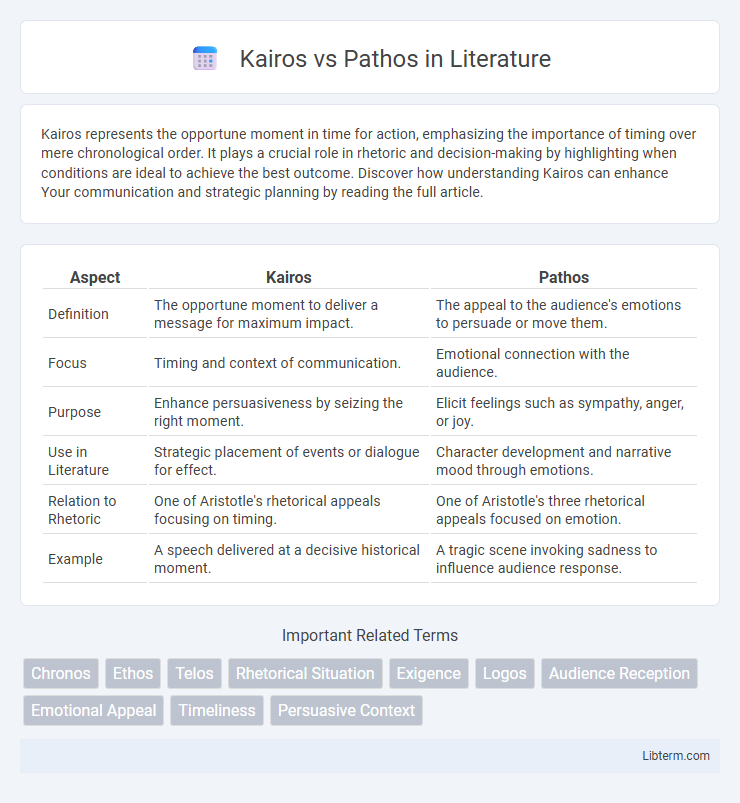Kairos represents the opportune moment in time for action, emphasizing the importance of timing over mere chronological order. It plays a crucial role in rhetoric and decision-making by highlighting when conditions are ideal to achieve the best outcome. Discover how understanding Kairos can enhance Your communication and strategic planning by reading the full article.
Table of Comparison
| Aspect | Kairos | Pathos |
|---|---|---|
| Definition | The opportune moment to deliver a message for maximum impact. | The appeal to the audience's emotions to persuade or move them. |
| Focus | Timing and context of communication. | Emotional connection with the audience. |
| Purpose | Enhance persuasiveness by seizing the right moment. | Elicit feelings such as sympathy, anger, or joy. |
| Use in Literature | Strategic placement of events or dialogue for effect. | Character development and narrative mood through emotions. |
| Relation to Rhetoric | One of Aristotle's rhetorical appeals focusing on timing. | One of Aristotle's three rhetorical appeals focused on emotion. |
| Example | A speech delivered at a decisive historical moment. | A tragic scene invoking sadness to influence audience response. |
Understanding Kairos: The Power of Timing
Kairos represents the opportune moment to deliver a message, emphasizing the perfect timing that maximizes impact and persuasion. It involves assessing the context, audience readiness, and cultural climate to ensure the message resonates effectively. Mastering kairos enhances communication by aligning content with the precise moment when it will be most influential.
Defining Pathos: Emotional Appeal in Rhetoric
Pathos in rhetoric refers to the emotional appeal used to persuade an audience by evoking feelings such as empathy, anger, or sadness. It contrasts with Kairos, which emphasizes the timeliness and appropriateness of the argument, by focusing on connecting with the audience's emotions to enhance persuasion. Effective use of Pathos can create a strong emotional response, making the message more memorable and impactful.
Historical Origins of Kairos and Pathos
Kairos and Pathos both originate from ancient Greek rhetoric, with Kairos emphasizing the opportune moment to deliver a message effectively, rooted in classical oratory practice. Pathos, traced back to Aristotle's rhetorical framework, focuses on evoking emotional responses to persuade an audience, underscoring the power of emotion in rhetoric. These concepts have shaped persuasive communication by combining timely delivery with emotional appeal since antiquity.
Kairos in Persuasive Communication
Kairos in persuasive communication refers to the strategic timing and context that enhances the effectiveness of a message, making it more compelling and relevant to the audience's current situation. Unlike pathos, which appeals to emotions, kairos emphasizes seizing the right moment to deliver arguments when the audience is most receptive. Mastering kairos involves understanding social, cultural, and situational cues to optimize persuasion by aligning the message with the opportune timing for maximum impact.
The Role of Pathos in Audience Engagement
Pathos plays a crucial role in audience engagement by appealing directly to emotions, making messages more relatable and memorable. Emotional triggers such as empathy, passion, and fear can drive audience connection and motivate action more effectively than purely logical appeals. Understanding and harnessing pathos enhances persuasive communication, deepening audience investment and response.
Comparing Kairos and Pathos in Rhetorical Strategy
Kairos emphasizes the opportune moment to deliver a message, harnessing timing to maximize persuasive impact, while Pathos appeals directly to the audience's emotions to evoke feelings that drive action. In rhetorical strategy, Kairos exploits contextual awareness, ensuring arguments align with the audience's current situation or cultural climate, whereas Pathos strategically triggers emotional responses such as empathy, fear, or passion. Effective persuasion often involves integrating Kairos and Pathos, balancing timely delivery with emotionally charged content to deeply resonate and motivate audiences.
Case Studies: Effective Use of Kairos vs Pathos
Case studies exemplify the effective use of kairos by demonstrating how timing and context amplify persuasive impact, such as political campaigns leveraging current events to sway voters. Pathos-driven campaigns showcase emotional connection by eliciting empathy or urgency, like charity ads invoking personal stories to inspire donations. Successful rhetoric often blends kairos and pathos, strategically aligning emotional appeals with opportune moments to maximize audience engagement.
Common Mistakes: Misusing Kairos and Pathos
Misusing kairos and pathos often leads to ineffective communication by confusing timing with emotional appeal. Kairos involves seizing the opportune moment to deliver a message, while pathos targets the audience's emotions to persuade. Overemphasizing pathos without regard for kairos can result in emotionally charged appeals that miss the crucial context or moment for maximum impact.
Integrating Kairos and Pathos for Maximum Impact
Integrating kairos and pathos enhances persuasive communication by aligning emotional appeal with the perfect timing and context. Kairos ensures the message resonates when the audience is most receptive, while pathos evokes strong emotions that drive engagement and action. Together, they create a powerful synergy that maximizes impact and influence in rhetoric and marketing strategies.
Kairos and Pathos in Modern Media and Marketing
Kairos in modern media emphasizes seizing timely moments to engage audiences with relevant content, driving immediate action and emotional resonance. Pathos leverages emotional appeal through storytelling, visuals, and tone to connect deeply with consumer values and desires. Effective marketing strategies combine Kairos' sense of urgency with Pathos' emotional influence to enhance brand persuasion and campaign impact.
Kairos Infographic

 libterm.com
libterm.com